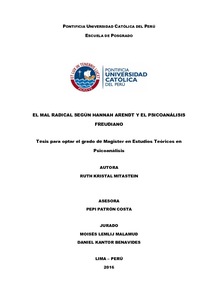| dc.contributor.advisor | Patrón Costa, Pepi | |
| dc.contributor.author | Kristal Mitastein, Ruth | es_ES |
| dc.date.accessioned | 2017-02-14T23:36:41Z | es_ES |
| dc.date.available | 2017-02-14T23:36:41Z | es_ES |
| dc.date.created | 2016 | es_ES |
| dc.date.issued | 2017-02-14 | es_ES |
| dc.identifier.uri | http://hdl.handle.net/20.500.12404/7800 | |
| dc.description.abstract | Buscamos establecer un paralelo entre algunos conceptos del psicoanálisis freudiano y el concepto kantiano del «mal radical», el cual fue adoptado por Hannah Arendt para referirse a las atrocidades cometidas por el régimen totalitario nazi contra los judíos en la Shoah.
Arendt considera el nazismo como un régimen totalitario basado en una ideología racial que proporcionó la «ficción creíble» que argumenta que gracias a las Leyes de la Naturaleza surgió la raza aria - «superior y pura» - para la cual su objetivo principal fue destruir a su contraparte, el pueblo judío «infrahumano». Los nazis utilizaron campos de concentración y exterminio para eliminar a millones de personas consideradas «superfluas» y «prescindibles».
En este artículo analizamos la obsesión de los nazis de exterminar a los «infrahumanos», utilizando, entre otros, el concepto psicoanalítico freudiano de la «pulsión de muerte» y sus subrogados, fenómenos de la psicología individual que se aplican a las masas colaboradoras de los nazis.
Entendemos el «mal radical» utilizado por Arendt como un constructo que abarca aspectos socio-económicos, políticos, filosóficos e históricos; simbólicamente, el mundo externo, mientras que los conceptos freudianos dan cuenta de la dinámica intrapsíquica inconsciente como sustrato del comportamiento destructivo, que representan el mundo interno. Argumentamos que ambos mundos: interno y externo se encuentran en permanente dinámica e interacción. Encontramos semejanzas y aspectos complementarios en los aportes de ambos Arendt y Freud.
Creemos que, en el sustrato inconsciente de los perpetradores nazis, ocurrieron los fenómenos psicológicos antes señalados, y además, que las acciones nazis fueron el producto del proceso secundario, del pensamiento consciente, con pleno uso de libertad de elección y de una voluntad pervertida. Reiteramos que la implementación del «mal radical» por los nazis es imputable. | es_ES |
| dc.description.abstract | In this work, we aim to establish a parallel between some elements in Freudian Psychoanalysis and the Kantian concept of «radical evil» adopted by Hannah Arendt to give an account of the atrocities committed by the Nazis against the Jews during the Holocaust.
Arendt considers Nazism to be a totalitarian regime based on a racist ideology which provided the so-called «credible fiction» which argues that thanks to the Laws of Nature, the «superior and pure» Arian Race emerged, for which its main objective was the destruction of its counterpart: the «subhuman» Jewish People. The Nazis used concentration and extermination camps for the elimination of millions of people considered superfluous and disposable.
We also analyze the Nazi obsession with the extermination of the «subhuman» using, among others, the psychoanalytic Freudian concept of the «death drive» and its subrogates, concepts that describe a phenomenon of individual psychology applied to the masses which collaborated with the Nazis.
We understand the concept of «radical evil» used by Arendt as a construct that encompasses socio-economic, political, philosophical and historical aspects, symbolizing the external world, while the Freudian concepts give rise to an intra-psychological dynamic unaware of its role as the substrate of destructive behavior, representing the internal world. We argue that both worlds: the external and the internal, exist in perpetual interactive dynamics. We thus find similarities and complementary aspects in the contributions of Freud and Arendt.
We believe that in the unconscious substrate of the Nazi perpetrators of evil the above mentioned psychological phenomena took place. Moreover, the explicit actions undertaken by the Nazis were the product of a secondary process, of conscious thought, with full use of freedom of choice and an evil will. Therefore, we reiterate that the implementation of the «radical evil» by the Nazis is imputable. | es_ES |
| dc.language.iso | spa | es_ES |
| dc.publisher | Pontificia Universidad Católica del Perú | es_ES |
| dc.rights | info:eu-repo/semantics/openAccess | es_ES |
| dc.rights.uri | http://creativecommons.org/licenses/by-nc-nd/2.5/pe/ | * |
| dc.subject | Arendt, Hannah, 1906-1975--Estudio y crítica | es_ES |
| dc.subject | Freud, Sigmund, 1856-1939--Estudio y crítica | es_ES |
| dc.subject | Kant, Immanuel, 1724-1804--Estudio y crítica | es_ES |
| dc.subject | Psicoanálisis | es_ES |
| dc.title | El mal radical según Hannah Arendt y el psicoanálisis freudiano | es_ES |
| dc.type | info:eu-repo/semantics/masterThesis | es_ES |
| thesis.degree.name | Maestro en Estudios Teóricos en Psicoanálisis | es_ES |
| thesis.degree.level | Maestría | es_ES |
| thesis.degree.grantor | Pontificia Universidad Católica del Perú. Escuela de Posgrado | es_ES |
| thesis.degree.discipline | Estudios Teóricos en Psicoanálisis | es_ES |
| renati.discipline | 313107 | es_ES |
| renati.level | https://purl.org/pe-repo/renati/level#maestro | es_ES |
| renati.type | http://purl.org/pe-repo/renati/type#tesis | es_ES |
| dc.publisher.country | PE | es_ES |
| dc.subject.ocde | https://purl.org/pe-repo/ocde/ford#5.01.00 | es_ES |






